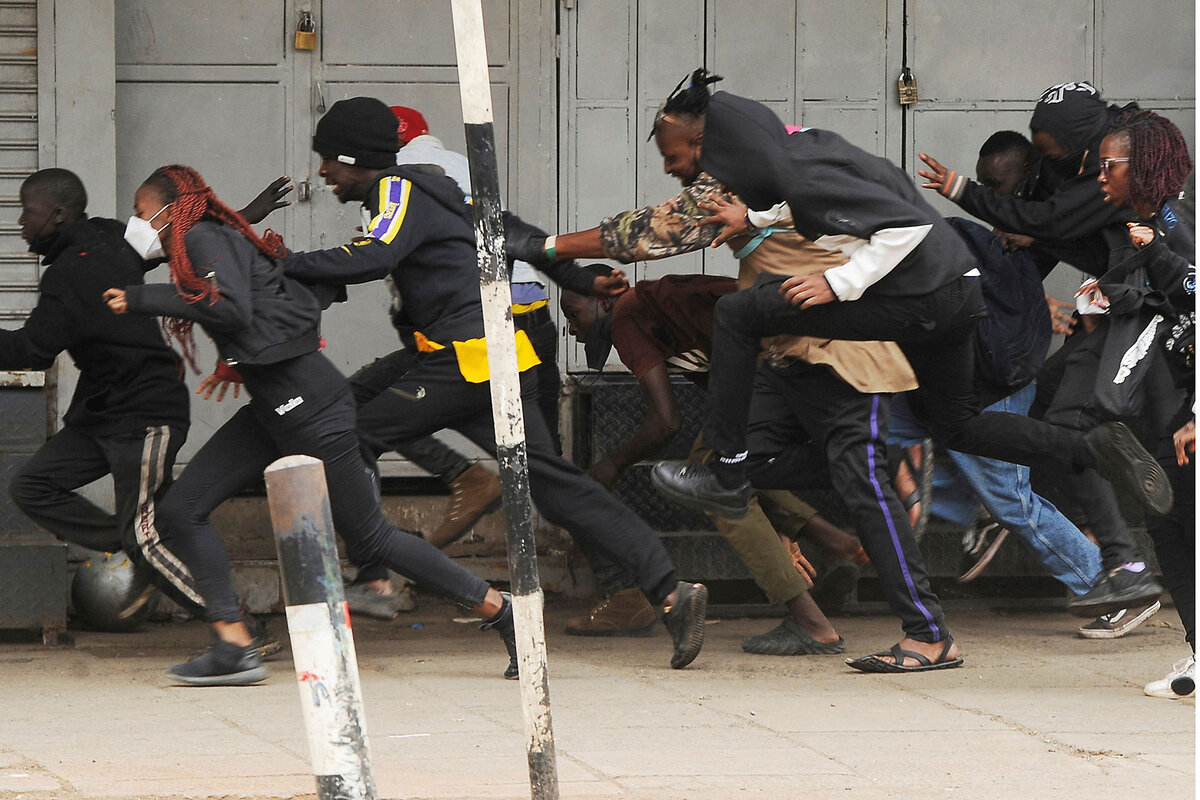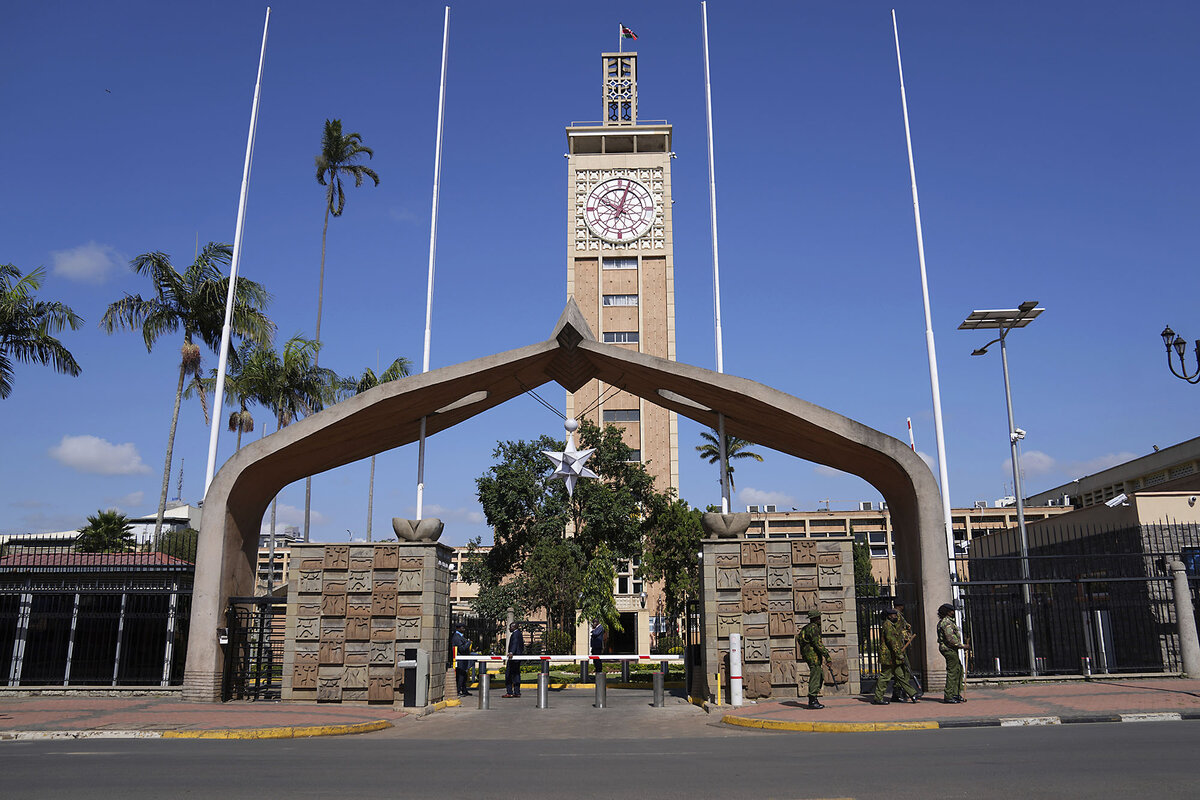Protests continue in Kenya after president ditches tax hikes. Here’s why.
Loading...
Protestors clashed with police on the streets of Kenya’s capital, Nairobi, again on Thursday, as demonstrations that began in response to a proposed tax hike morphed into a more general outpouring of anger against the country’s leadership.
Thursday’s standoff came after a week of violence that has left the country reeling. On Tuesday, demonstrators stormed Parliament, setting part of the building alight and causing lawmakers to flee. Security forces then opened fire, killing 19 people. An additional four deaths have been reported over the past week.
Why We Wrote This
Youth-led protests against tax hikes in Kenya this week turned violent as police killed 23 people, and demonstrators set fire to Parliament. At the root of the demonstrations is growing discontentment with the country’s leadership.
The protests were in response to proposed tax hikes on a range of goods, which President William Ruto said were necessary to help the country pay off its ballooning debts and keep the government running. But citizens balked, arguing that the cost of living in Kenya is already unmanageable and government should instead find the funds it needs by curbing corruption and its own excessive spending.
In response, Mr. Ruto announced Wednesday evening that he would not sign the controversial finance bill that set off the protests. But some protestors vowed to continue, and on Thursday, the crowds chanted their next demand: “Ruto must go!”
Protestors clashed with police on the streets of Kenya’s capital, Nairobi, again on Thursday, as demonstrations that began in response to a proposed tax hike morphed into a more general outpouring of anger against the country’s leadership.
Thursday’s standoff came after a week of violence that has left the country reeling. On Tuesday, demonstrators stormed Parliament, setting part of the building alight and causing lawmakers to flee. Security forces then opened fire. The death toll over the past week has reached 23 protesters killed by police.
President William Ruto announced Wednesday evening that he would not sign the controversial finance bill that set off the protests. But some protestors vowed to continue, and on Thursday, the crowds chanted their next demand: “Ruto must go!”
Why We Wrote This
Youth-led protests against tax hikes in Kenya this week turned violent as police killed 23 people, and demonstrators set fire to Parliament. At the root of the demonstrations is growing discontentment with the country’s leadership.
What triggered these protests?
In May, Mr. Ruto introduced a finance bill in Parliament that included tax hikes on essential goods including bread, cooking oil, diapers, and sanitary products. His government argued the increases were necessary to raise $2.7 billion to help pay off Kenya’s debts and keep the government running.
However, the bill immediately provoked an outcry in a country where many are struggling to make ends meet as prices rise faster than incomes. Many Kenyans argued that instead of further taxing citizens, the government should stop corruption and curb its own excessive spending. In May, for instance, President Ruto spent $1.5 million to charter a private jet to the United States for an official visit.
“This is an issue of extreme poverty and the fact that [many Kenyans feel] there is no future for them,” says John Mukum Mbaku, chair of the program committee at the Nairobi-based African Economic Research Consortium.
In response to the controversy, Mr. Ruto’s government dropped many of the proposed taxes, forging ahead with a modified version of the bill.
But the damage was done. Anger spread widely on social media – particularly TikTok – and last week, demonstrators, most of them young and working-class, began taking to the streets in Nairobi and other cities to protest the remaining tax hikes.
“They believe that the government, which came into power with the promise of putting poor people at the center of economic policy, has reneged on those promises and is doing exactly the opposite,” Dr. Mbaku says.
How did a youth-led antitax movement turn so deadly?
Protests began early last week and quickly built momentum across the country. There were scattered clashes with police, who used tear gas and water cannons to disperse crowds.
Then on Tuesday, lawmakers passed the revised finance bill. Defiant demonstrators forced their way into Parliament in Nairobi and set parts of the building on fire. Police began to fire live bullets into the crowds, killing 19 people.
“It was hard to see Kenyans dead on Parliament Road,” says lawyer Ian Mbotela, who has spent the past week representing arrested protestors and advocating for their rights during the demonstrations. “We have had our hearts broken seeing the current government breaching the human rights of our fellow Kenyans.”
On Wednesday, Mr. Ruto announced that he was withdrawing the finance bill. “Listening keenly to the people of Kenya who have said loudly that they want nothing to do with this finance bill 2024, I concede,” he said in a televised address.
What happens next?
Mr. Ruto’s reconsideration of the finance bill has not stopped calls for his resignation, and protests continued Thursday nationwide. In Nairobi, some demonstrators attempted to march on the State House, Mr. Ruto’s official residence.
But compared with earlier in the week, their numbers were smaller. Meanwhile, international observers urged the Kenyan government to open a dialogue with the country’s youth. Volker Türk, the United Nations high commissioner for human rights, wrote on X that he urged “restraint to facilitate the rights to peaceful assembly & expression, and dialogue to listen to the voices of young people. Investigations & accountability essential.”
In Kenya, Mr. Mbotela and other lawyers said they plan on suing the police for use of excessive force, as well as what they describe as an illegal deployment of Kenya’s military on protesters during the rallies.
The Kenya National Commission on Human Rights, a state-funded watchdog organization, reported that in addition to the 23 people who died in the protests, 300 had been injured as of Thursday.
“Those who have caused harm to peaceful protesters will be held accountable,” he says.









